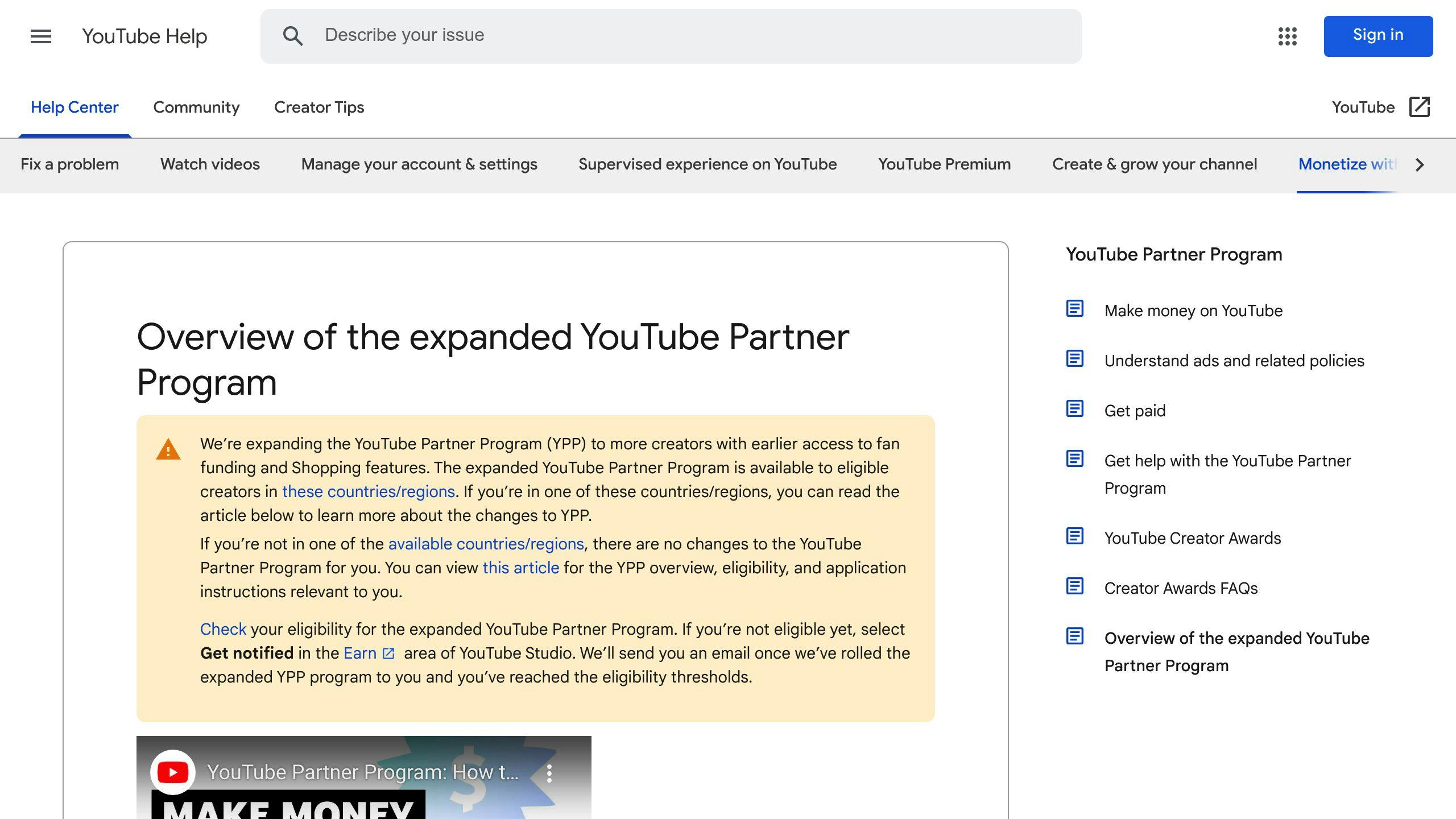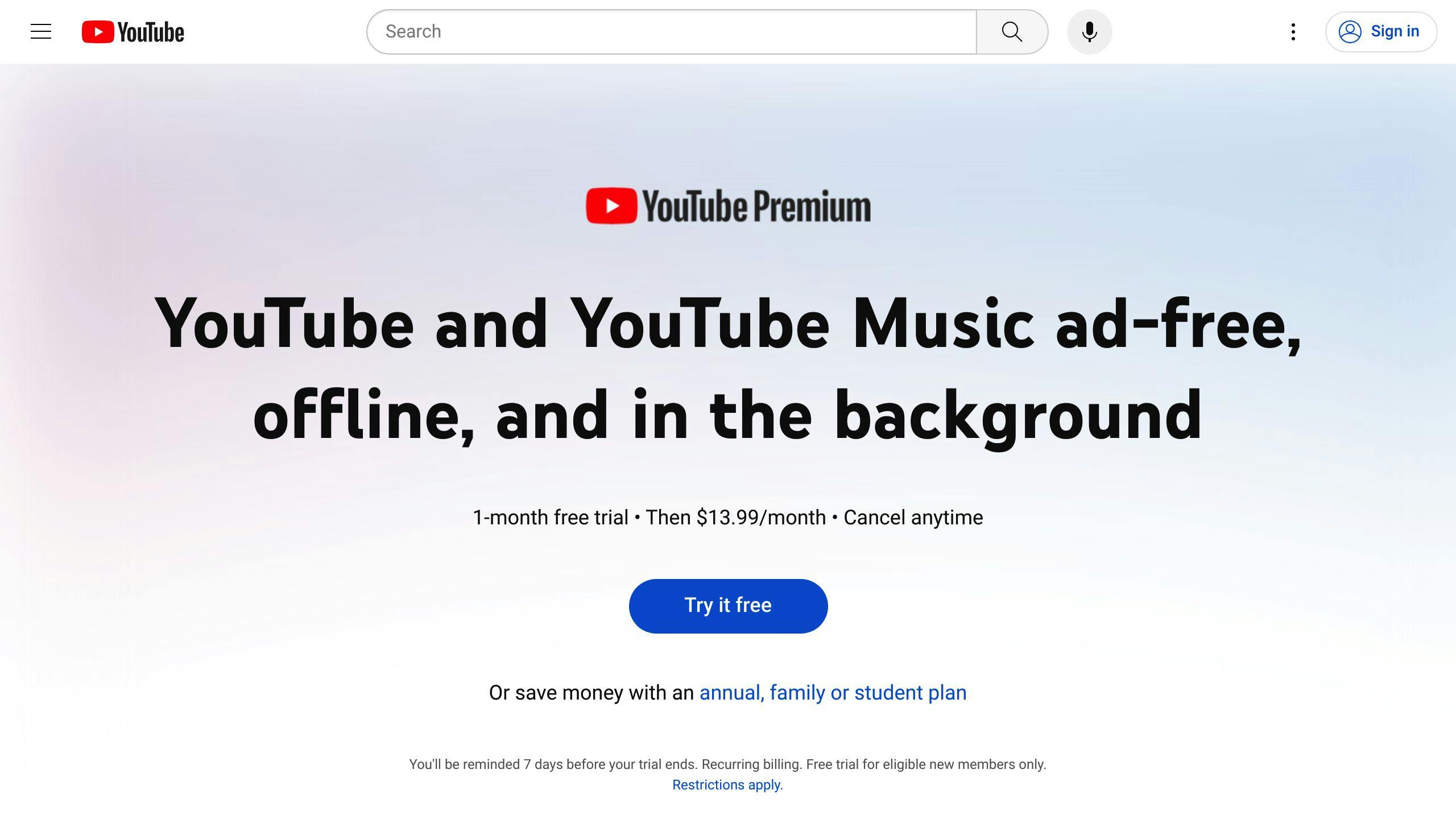Here's a quick overview of YouTube's ad revenue sharing system:
- YouTube splits ad revenue 55/45 with creators (creators get 55%)
- To earn, you must join the YouTube Partner Program (YPP)
- YPP requirements: 1,000+ subscribers, 4,000+ watch hours in 12 months
- Main ad types: display, overlay, skippable/non-skippable video, bumper
Key factors affecting earnings:
- CPM (cost per 1,000 ad views)
- RPM (revenue per 1,000 video views)
- Video topic, audience, and engagement
| Revenue Source | Description |
|---|---|
| Ad revenue | Main income from video ads |
| Channel memberships | Paid perks for subscribers |
| Super Chat/Stickers | Paid messages in live streams |
| Merchandise shelf | Sell branded products |
| YouTube Premium | Revenue from Premium viewers |
To maximize earnings:
- Create engaging content
- Optimize video length and ad placement
- Target advertiser-friendly topics
- Diversify income streams
- Use YouTube Analytics to track performance
Remember to set up AdSense, reach payment thresholds, and handle taxes properly.
Related video from YouTube
YouTube Partner Program (YPP)

What is YPP?
The YouTube Partner Program (YPP) helps creators make money from their YouTube channels. It offers ways to earn money and grow your audience.
YPP Eligibility Requirements
To join YPP, you need:
| Requirement | Details |
|---|---|
| Subscribers | 1,000 |
| Watch time | 4,000 hours in 12 months |
| OR | 10 million Shorts views in 12 months |
| Channel status | No active community guideline strikes |
| Location | Country where YPP is available |
| Policies | Follow YouTube's monetization rules |
How to Apply for YPP
Follow these steps to apply:
- Read YPP terms of service
- Set up Google AdSense account
- Turn on 2-step verification
- Apply in YouTube Studio
- Wait for YouTube's decision
After you apply, YouTube will check your channel and let you know if you're accepted.
Ad Revenue Sharing Basics
The 55-45 Revenue Split
YouTube shares ad money with creators using a simple split:
| Party | Share of Ad Revenue |
|---|---|
| YouTube | 45% |
| Creator | 55% |
This means for every $1 in ad money, YouTube keeps $0.45 and the creator gets $0.55. This split applies to all ad types on YouTube.
What Affects Revenue Share Percentages
While 55-45 is the usual split, some things can change it:
- YouTube Premium creators may get a bigger share
- Big channels with lots of viewers might get better deals
Revenue Splits for Different Ad Types
YouTube has many ad types, each with its own split:
| Ad Type | Revenue Split |
|---|---|
| Display ads | Lower share |
| Video ads | Standard share |
| Sponsored cards | Higher share |
Knowing these splits can help you pick the best ads for your channel.
Types of YouTube Ads
YouTube has many ad types for different goals. Knowing these helps make better ads that work well and don't bother viewers too much.
Display Ads
These are picture ads that show up:
- On YouTube's main page
- In search results
- Next to related videos
They help:
- Get people to visit websites
- Make more people know about brands
- Sell products
Overlay Ads
These ads:
- Are see-through
- Show up at the bottom of videos
- Can be closed by viewers
- Don't bother viewers as much as other ads
Skippable Video Ads
Also called TrueView ads, these:
- Let viewers skip after 5 seconds
- Only cost money when people watch 30 seconds or click
- Can be used for many goals
Non-Skippable Video Ads
These ads:
- Must be watched before the video
- Can be up to 20 seconds long
- Are good for making people know about brands
- Might annoy some viewers
Bumper Ads
Bumper ads are:
- Short (6 seconds or less)
- Can't be skipped
- Show before videos
- Good for quick brand messages
Sponsored Cards
These ads:
- Show up as a small teaser
- Can be clicked for more info
- Are good for getting clicks to websites
| Ad Type | Can Skip? | Length | Main Use |
|---|---|---|---|
| Display | Yes | N/A | Brand awareness |
| Overlay | Yes | N/A | Less pushy ads |
| Skippable Video | After 5s | Varies | Flexible |
| Non-Skippable Video | No | Up to 20s | Strong brand messages |
| Bumper | No | 6s or less | Quick brand reminders |
| Sponsored Cards | Yes | N/A | Getting website visits |
How YouTube Calculates Ad Revenue
YouTube uses two main ways to figure out ad money: Cost Per Mille (CPM) and Revenue Per Mille (RPM). Knowing these helps creators earn more.
Cost Per Mille (CPM)
CPM is how much it costs to show ads 1,000 times. Here's how it works:
- Advertisers set how much they'll pay
- YouTube picks the highest offer
- The amount changes based on topic, viewers, ad type, and how many advertisers want to show ads
Revenue Per Mille (RPM)
RPM is how much money a creator makes for every 1,000 views. It includes:
- The CPM
- How many people click or watch ads
- Other things that affect earnings
RPM gives a better idea of how much a creator actually makes.
What Changes Ad Rates
Ad rates go up or down because of:
| Factor | How It Affects Rates |
|---|---|
| Topic | Some topics (like money or tech) pay more |
| Viewers | Advertisers pick who they want to reach |
| Ad type | Different kinds of ads cost different amounts |
| Demand | More advertisers mean higher rates |
CPM and RPM in Different Topics
Different topics have different CPM and RPM:
| Topic | CPM | RPM |
|---|---|---|
| Money | $20-$50 | $10-$25 |
| Tech | $15-$30 | $8-$20 |
| Fun | $5-$15 | $3-$10 |
Knowing these numbers helps creators make more money from their videos.
Other Ways to Make Money on YouTube
Besides ads, YouTube offers more ways to earn money from your channel.
Channel Memberships
Channel Memberships let you offer special content to fans who pay monthly. To use this:
- You need 1,000+ subscribers
- Your channel must follow YouTube's rules
You can set up different levels with various perks like:
- Special posts
- Badges for loyal fans
- Access to live chat
Super Chat and Super Stickers
These features let viewers pay to highlight their messages during live streams.
| Feature | How it works |
|---|---|
| Super Chat | Viewers pay to make their messages stand out |
| Super Stickers | Viewers buy and send animated pictures in chat |
Both can help you earn more, especially during popular live events.
Selling Merchandise on YouTube
You can sell your own branded items on YouTube. To do this:
- Have at least 10,000 subscribers
- Follow YouTube's money-making rules
Use the Merchandise Shelf to show your products under your videos.
Earning from YouTube Premium

YouTube Premium is a paid service that removes ads and offers more features. As a creator:
- You get money when Premium members watch your videos
- You need 1,000+ subscribers and follow YouTube's rules
Comparison of Monetization Methods
| Method | Subscriber Requirement | Main Benefit |
|---|---|---|
| Channel Memberships | 1,000+ | Regular income from loyal fans |
| Super Chat/Stickers | None specified | Extra money during live streams |
| Merchandise | 10,000+ | Income from selling your own products |
| YouTube Premium | 1,000+ | Money from ad-free views |
Using YouTube Analytics
YouTube Analytics helps you understand how your channel is doing and how to make more money from ads. Here's what you need to know:
Key Metrics for Ad Revenue
When looking at your ad money, pay attention to these numbers:
| Metric | What It Means |
|---|---|
| Estimated earnings | How much money you've made from ads |
| Monetizable playbacks | How many times your videos played with ads |
| Ad impressions | How many times ads showed on your videos |
| Click-through rate (CTR) | How often people click on ads |
| Cost per mille (CPM) | How much money 1,000 ad views make |
How to Read Revenue Reports
To see your money reports:
- Go to YouTube Studio
- Click on Analytics
- Click on Revenue
You'll see a breakdown of your earnings, video plays, ad views, clicks, and how much money ads make.
Using Data to Make More Money
Look at your YouTube Analytics to:
| Action | How It Helps |
|---|---|
| Try different ad types | Get more clicks and make more money |
| Make better videos | Keep people watching longer |
| Find the right viewers | Focus on people who make you more money |
| Try new ways to earn | Use things like channel memberships or sell stuff |
sbb-itb-bc761f5
Getting Paid by YouTube
To get money from YouTube, you need to set up AdSense, reach payment limits, and know how payments work.
Setting Up AdSense
AdSense lets you make money from your videos. Here's how to set it up:
- Join the YouTube Partner Program (YPP)
- Click "Setup your Google AdSense account" in YouTube Studio
- Choose to make a new account or use an existing one
- Give tax info and prove who you are
- Add how you want to be paid (like bank account or PayPal)
Payment Limits and Timing
YouTube pays once a month if you've earned at least $100. If you earn less, it carries over to next month. To get paid:
| Step | Action |
|---|---|
| 1 | Earn more than $100 |
| 2 | Pick how you want to be paid |
| 3 | Confirm your address with a PIN from AdSense |
Payments Around the World
AdSense works with many types of money. You can choose which type you want to be paid in. Remember:
- Money exchange rates might apply
- You might need to pay taxes on what you earn
- Some countries have special tax rules, so you might need to give more info to AdSense
| Payment Method | Description |
|---|---|
| Electronic Funds Transfer (EFT) | Money goes straight to your bank |
| Check | Paper check sent by mail |
| Wire Transfer | Bank-to-bank money transfer |
| Western Union | Cash pickup at Western Union locations |
Taxes on YouTube Earnings
As a YouTuber, you need to know about taxes on your earnings. Not paying taxes can lead to fines.
U.S. Tax Rules for Non-U.S. Creators
If you're not from the U.S., you still need to follow U.S. tax laws:
| Requirement | Description |
|---|---|
| Tax withholding | Google may keep some of your earnings from U.S. viewers for taxes |
| Tax information | You need to give this to avoid withholding |
| U.S. tax return | You might need to file one and report your YouTube income |
Reporting YouTube Income on Taxes
As a YouTuber, you're self-employed. This means:
- You must report your YouTube income on your tax return
- Keep track of what you earn and spend
- You might need to file a Schedule C (Form 1040) for your business income and costs
Tax Rules by Country
Tax laws are different in each country:
| What to Know | Action to Take |
|---|---|
| Your country's rules | Learn about them |
| Reporting income | You may need to do this even if you're not from the U.S. |
| Getting help | Talk to a tax expert if you're not sure what to do |
How to Increase Ad Revenue
To make more money from ads on YouTube, focus on making good videos that people like and that advertisers want to use. Here are some ways to do this:
Getting More Views and Engagement
To get more advertisers and make more money, you need more people to watch and interact with your videos. Try these tips:
- Make good videos that people want to watch
- Use good titles, descriptions, and tags so people can find your videos
- Share your videos on social media and other websites
- Talk to your viewers by answering comments and asking what they think
Best Video Length and Ad Placement
How long your videos are and where you put ads can change how much money you make. Here's what to do:
| Tip | Why It Helps |
|---|---|
| Try different ad lengths and places | Find what works best for your videos |
| Put ads at the start, middle, or end | Get more people to watch ads |
| Use ads people can skip | Let viewers choose if they want to watch |
Making Content Advertisers Like
To get more advertisers and make more money, make videos they want to use. Here's how:
- Make videos about popular topics
- Use good pictures and sound in your videos
- Don't make videos about things that might upset people
- Think about making videos for specific groups of people
| Do This | Don't Do This |
|---|---|
| Make videos about popular topics | Make videos about upsetting topics |
| Use good pictures and sound | Use poor quality video or audio |
| Make videos for specific groups | Try to please everyone |
| Keep up with trends | Ignore what's popular |
Challenges in Earning Ad Revenue
Making money from ads on YouTube can be hard. Here are some problems creators face and how to deal with them:
Avoiding Demonetization
Demonetization means losing the ability to make money from ads. To avoid this:
| Do | Don't |
|---|---|
| Follow YouTube's rules | Use bad language |
| Make safe content | Talk about risky topics |
| Use your own stuff | Use others' work without permission |
How Ad-Blocking Affects Revenue
Ad-blockers stop ads from showing, which means less money for creators. To help with this:
- Ask viewers to turn off ad-blockers for your channel
- Try other ways to make money, like selling products
Dealing with Changing Ad Rates
Ad rates on YouTube go up and down. This can mean less money sometimes. To handle this:
| Strategy | How It Helps |
|---|---|
| Try different ways to make money | Don't rely only on ads |
| Use various ad types | Some might pay more |
| Make content advertisers like | Get better-paying ads |
The Future of YouTube Ad Revenue
YouTube's way of making money from ads is always changing. Let's look at what might happen next, including new ways to earn money, possible changes to how YouTube shares money, and how things might be different in the future.
New Ways to Make Money on YouTube
YouTube is trying out new ways for creators to earn money:
| New Feature | How It Works |
|---|---|
| Super Thanks | Viewers can buy a special badge during live streams |
| Shopping in videos | Creators can tag products and earn money from sales |
These new features are still being tested but could help creators make more money in the future.
Possible Changes to How YouTube Shares Money
YouTube might change how it shares money with creators:
- New types of ads that give creators more money
- More choices for creators to control how they earn
- Clearer information about how much creators make and why
Some people think YouTube might give creators a bigger share of the money from ads in the future.
How Things Work Now vs. How They Might Work Later
Right now, YouTube pays creators based on how many people see and click on ads. But this might change:
| Current Model | Possible Future Models |
|---|---|
| Pay per 1,000 views (CPM) | Pay per action (like when someone buys something) |
| Monthly fees for special content |
These new ways of making money could be good for different types of creators:
- Pay per action: Good for creators who make videos about buying things
- Monthly fees: Good for creators with loyal fans who want extra content
We don't know exactly what will happen, but YouTube will keep changing how creators can make money. Creators who stay up-to-date with these changes will have the best chance to make more money from their videos.
Conclusion
Key Takeaways
To make money from YouTube ads, creators need to know how the system works. We've covered:
- YouTube Partner Program
- How ad money is shared
- Types of YouTube ads
- How to figure out ad earnings
- Other ways to make money on YouTube
- Using YouTube Analytics
- Getting paid by YouTube
- Taxes on YouTube earnings
- Problems with making money from ads
Why You Should Have Multiple Income Sources
YouTube's ad system changes often. To keep making money, creators should:
| Income Source | Why It's Good |
|---|---|
| Ad revenue | Main way to earn on YouTube |
| Affiliate marketing | Make money by recommending products |
| Sponsored content | Get paid to talk about brands |
| Merchandise sales | Sell your own products to fans |
| Channel memberships | Offer special content for a fee |
Having different ways to make money helps when:
- YouTube changes its rules
- Ad rates go down
- Some videos can't have ads
FAQs
How does YouTube revenue sharing work?
YouTube splits money with creators based on their partner agreements. To see your share:
- Go to YouTube Studio
- Click Settings in the left menu
- Check your agreements for details
What are the main types of YouTube ads?
| Ad Type | Description |
|---|---|
| Non-skippable in-stream | Must watch before video |
| In-feed video | Show up in search results |
| Bumper | Short, can't skip |
| Outstream | Play outside YouTube |
How can I make more money on YouTube?
Try these steps to boost your earnings:
| Step | Action |
|---|---|
| 1 | Turn on ads for all videos |
| 2 | Add mid-roll ads |
| 3 | Use other money-making features (like memberships, Super Chat) |
These tips can help you get more from your YouTube channel.



